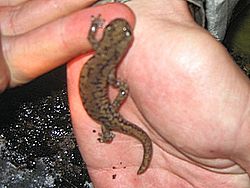| Web-toed salamanders | |
|---|---|
 | |
| Hydromantes platycephalus | |
| Scientific classification | |
| Kingdom: | Animalia |
| Phylum: | Chordata |
| Class: | Amphibia |
| Order: | Urodela |
| Family: | Plethodontidae |
| Subfamily: | Plethodontinae |
| Genus: | Hydromantes Gistel, 1848 |
| Species | |
5, See table. | |
Hydromantes, commonly referred to as web-toed salamanders, is a genus of the lungless salamander family, Plethodontidae; they achieve respiration through their skin and the tissues lining their mouth. They are endemic to mountains of California in the United States. [1] Salamanders of this genus are distinguished in having extremely long tongues that they can project to 80% of their body length. [2] Similar species endemic to southern France and Italy are now classified in a distinct genus, Speleomantes .